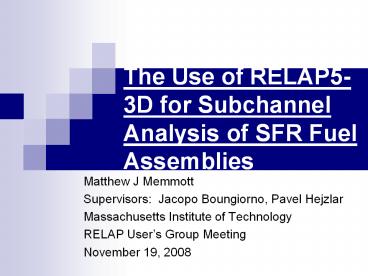The Use of RELAP5-3D for Subchannel Analysis of SFR Fuel Assemblies - PowerPoint PPT Presentation
1 / 35
Title:
The Use of RELAP5-3D for Subchannel Analysis of SFR Fuel Assemblies
Description:
MIT Nuclear Science and Engineering. 3. 8/27/09. Background ... 1. I. E. Idelchik, 'Handbook of Hydraulic Resistance Second Edition', pg. ... – PowerPoint PPT presentation
Number of Views:708
Avg rating:3.0/5.0
Title: The Use of RELAP5-3D for Subchannel Analysis of SFR Fuel Assemblies
1
The Use of RELAP5-3D for Subchannel Analysis of
SFR Fuel Assemblies
- Matthew J Memmott
- Supervisors Jacopo Boungiorno, Pavel Hejzlar
- Massachusetts Institute of Technology
- RELAP Users Group Meeting
- November 19, 2008
2
Outline
- Background
- Subchannel Model
- Benchmarks
- Application
- Results/Conclusions
- Future Work
3
Background
- SFR is currently the fast reactor of choice under
GNEP (ABR1000) - MIT is investigating innovative fuel designs
(annular fuel, bottle shaped, etc.) - Subchannel analyses required fuel temps, clad
temps, coolant velocities, etc. - Current subchannel codes cannot handle
nonstandard geometries
4
Subchannel Model
- 4 Primary Considerations
- Subchannel Geometry
- Cross-Flow
- Sodium Conduction
- Turbulent Mixing
5
Subchannel Geometry (I)
6
Subchannel Geometry (II)
- Composed of multiple 22 segment pipes
- 2 segments for entrance/exit and shielding
- 5 segments for plenum
- 15 segments for core
- Fuel rods divided into 6 segments (no peaking)
- Allows for connection to each subchannel
- Cannot evaluate azimuthal conduction in rods
- Inlet conditions controlled by time dependent
volume/junction
7
Subchannels only (I)
8
Subchannels Only (II)
9
Cross-Flow (I)
- Multiple junctions Each volume of the pipe is
connected to the adjacent subchannel volume of
the same number - Transverse bundle flow resistances1
- Area equal to transverse area of the subchannel
- Volume lengths in y and z input for each volume
- VERY little mixing, almost no mixing due to tight
pitch of the core/uniform velocity profile.
1. I. E. Idelchik, Handbook of Hydraulic
Resistance Second Edition, pg. 608, Hemisphere
Publishing Corporation, New York, USA, 1986.
10
Cross-Flow (II)
- Pressure-gradient driven
- Modeled in RELAP5 using horizontal junctions
- Creates an outlet temperature profile
11
Sodium Conduction
- Heat transfer due to conduction
- Axial Conduction
- Radial Conduction
- Fouriers Law
- Control variables (CVs) in RELAP5-3D
- Requires over 5,000 CVs limit is 10,000
12
Axial Conduction (full power)
13
Axial Conduction (4 power)
14
Radial Conduction (full power)
15
Radial Conduction (4 flow)
16
Turbulent Mixing (I)
- Mixing due to wire-wrap
- Two regions of turbulent mixing
- Inner channels
- Edge and Corner Channels
- Mixing modeled by two parameters
- e - Effective Eddy Diffusivity
- C1L Swirl Ratio
17
Turbulent Mixing (II)
e - Effective Eddy Diffusivity
- Induced coolant swirling caused by wire wrap
enhances mixing - Total mass flow in/out of each subchannel face is
zero - Enhanced mixing flattens temperature profile in
interior
18
Turbulent Mixing (III)
- C1L Swirl Ratio
- Unidirectional orientation of wire-wrap causes a
transverse flow in edge channels - This flow results in a circular flow inside duct
wall - C1L is the ratio of transverse to axial flow in
the edge channels - Effect of edge swirl velocity is to equalize
edge/corner channel temperatures
19
Effect of Mixing
20
Constraints
- Limiting feature of model is control variables
- 6 control variables per volume
- 22 volumes per subchannel
- 51 subchannels for 9 ring, 1/12 assembly model
- 6732 Control variables out of 10,000 possible
21
SUPERENERGY II
- Developed by Chen and Todreas
- Only valid for solid pin, hexagonal assemblies
- Calculates sodium properties at single T
- Can only evaluate 1-8 ring assemblies
- Created a SUPERENERGY II model matching an 8 ring
RELAP model - Outlet temperature profile comparison
22
Benchmark I
- Excellent Agreement 3C
- Sodium properties are temperature dependent
- The difference is due to the sodium properties
calculated in the RELAP5 model - RELAP5 more accurate
23
Benchmark II ORNL 19-Pin Test
24
ORNL 19-Pin Benchmark
25
Example Application of RELAP as a Subchannel
Analysis Code
- Cold assembly dimensions
- Rod-duct gap in edge channels is 1.21 mm
- Wire-wrap diameter is 0.805 mm
- Edge to interior subchannel flow area ratio 2.0
- This results in a LARGE temperature distribution
(70C) - Hot dimensionsstill large T distribution (35C)
- Flattened profile can be achieved by
- Decreasing edge channel area
- Increasing flow resistance in edge channels
26
Assembly Duct Ribs
27
RELAP5-3D Advantages
- Non-standard fuel geometries (annular, inverse,
thermal expansion, etc.) - Various assembly designs (wire-wrap, grid spaced,
duct ribs, etc.) - Temperature dependent coolant properties
- Detailed fuel rod analysis
- Steady State or Transient analyses
28
RELAP5-3D Disadvantages
- Huge input file (gt23,000 lines of code)
- Control Variable limited (13 rings)
- Long runtime (3 to 26 hours, depending on size)
- Can take significant time to modify input file
due to size and complexity
29
Results/Conclusions
- RELAP5-3D subchannel model capable of modeling
wide variety of fuel types, sodium cooled
assembly geometries, and conditions - RELAP5-3D model within acceptable performance
region dictated by benchmarking of traditional
subchannel SFR codes with ORNL19 pin - Scope of RELAP5-3D would be greatly enhanced by
the addition of a wire-wraped sodium subchannel
mixing option
30
Thank you!
- Questions?
31
Extra Slides
32
Annular Fuel
- Decrease number of rods
- Increase rod diameter
- Create inner coolant channel, providing internal
and external cooling of rod - Decrease clad surface temp
- Decrease fuel max temp
- Can safely increase power density
33
Bottle Neck Fuel
- Maintain constant plenum volume by decreasing
plenum radius and increasing height - Decreases pressure drop in assemblies
- Ideal plenum radius minimizes pressure drop at
low ?H - Potential for power uprate or decreased pump sizes
34
(No Transcript)
35
Original
Optimized































